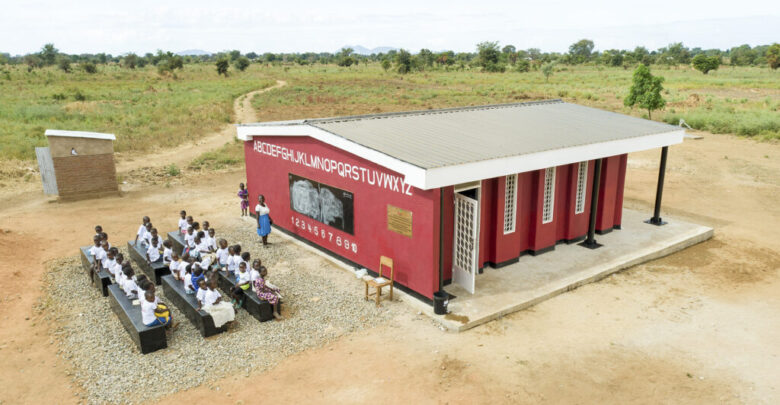

LILONGWE, Malawi — When the community of Mcheza village, Malawi, woke up on the morning of Nov. 26, 2021, they were in awe of a new structure that had sprouted out at the end of the schoolyard in the middle of the night.
“The night before, men were working on the site setting up equipment and, in the morning, a whole new school block was standing on the ground reserved for a school,” Senior Chief Kalonga told Zenger News on the sidelines of an event to hand over the classroom to the community on June 18, 2021.
The classroom, printed overnight, is the world’s first 3D printed school, according to French firm 14Trees that constructed the classroom block in under 15 hours.
Mcheza village, in the lakeshore district of Salima, 100 kilometers (62 miles) west of the capital Lilongwe, mirrors a typical Malawian village: a few sparse homesteads sprung across the open veld surrounded by dry farming fields that come to life during the farming season.

Like most Malawian villages, schools are far and wide apart, forcing learners to walk long distances to the nearest school.
Marita Feliat’s eight-year-old daughter Triza, who is one of the first students to register at the yet-to-be-named new school, gleams with excitement at the prospect.
Triza, a Grade 2 learner, was born with a disability on her left foot, rendering her unable to walk long distances on days when her leg hurt.
“Her last school was over 5 kilometers (3.1 miles) away, and it was challenging for her to attend classes on some days,” she told Zenger News.
“So, with school in our village, I am delighted because my daughter will now be able to attend classes every day.”

According to the United Kingdom charity Classrooms for Malawi, the country needs to build more than 40,000 classrooms to cater to demand.
“Based on our calculations, if we rely on conventional methods, it would take about 70 years to clear that backlog,” 14Trees managing director François Perrot told Zenger News.
“To remove that backlog faster, we need to constructively disrupt the way we build and apply a cutting-edge approach that can bring speed, efficiency, and environmental performance at scale. This is what 3D printing technology achieves.”
During the handover of the classroom to the community, Juliana Kuphanga Chikandila, a primary education advisor representing the Director of Education in the Ministry of Education in Malawi, said she was impressed with the new building.
“Its durability and design provide the space and facilities that students did not have before; teaching and learning can now happen inside and outside the classroom,” she said.

“It is notably different from the other schools being built in the district. This school will attract more students, and those learners that had left will return.”
14Trees was co-founded by the world leader in building materials LafargeHolcim, and CDC Group, the United Kingdom’s development finance institution and impact investor, said Perrot.
Both have invested in the 3D printing technology and are bringing it to Malawi, where it is most needed.
“We believe the school infrastructure gap could be bridged in just ten years using 3D printing,” Perrot told Zenger News.
Perrot explained that with 3D printing, the classroom walls could be built in less than 15 hours, while the walls could be raised in less than 12 hours.

“This method reduces the number of materials needed and decreases the carbon footprint of those buildings by up to 70 percent compared to conventional methods. Considering the volume of the units required to print, we believe that 3D printed buildings can be 10 to 20 percent more cost-effective than conventional methods soon.”
Catherine Sani, the recently-elected president of the Malawi Institute of Architects, noted that while it seems fair and reasonable to say that Malawi will benefit from the technology given its lack of critical infrastructure, benefits will also be felt from the skills transfer.
“It is difficult to comment whether the French firm has considered any local skills transfer and made any efforts to embark on the transference of skill,” she told Zenger News.
“The speed of production by this method is beneficial, but one cannot look at speed alone from costs related with printing machines, technology transfer, and ensuring good design.”
But Perrot said that 3D printing is still a nascent technology, and 14Trees is working on several aspects to make it more affordable by 10-20 percent than the conventional methods in the next 12-18 months.

“We had to import the pilot school, but the ink we used to print the walls is now manufactured in Malawi. Manufacturing the ink on the ground will dramatically reduce the cost of the building for buyers and create local jobs in manufacturing. In addition, we now have an indigenous-Malawian team fully trained to operate the printer. We are confident that we can build schools that are more superior and improve on construction time, quality, environmental footprint, and affordability.”
Perrot notes that 3D printing will help to unlock the potential for affordable housing and schools in Africa.
“We are now working on 3D printed home projects in Kenya and Zimbabwe, with houses built by the end of this year. We also have school projects that we will build in Malawi and Madagascar, and Ethiopia. We have identified opportunities to deliver sanitation projects. We are proud that Malawi has been the first country to show 3D printing of social infrastructure is possible. We will leverage the competencies built by our team here in Malawi to roll out that technology, supporting the expansion across the region.”
(Edited by Kipchumba Some and Anindita Ghosh. Map by Urvashi Makwana)
The post French Firm Unveils World’s First 3D Printed School In Malawi appeared first on Zenger News.



